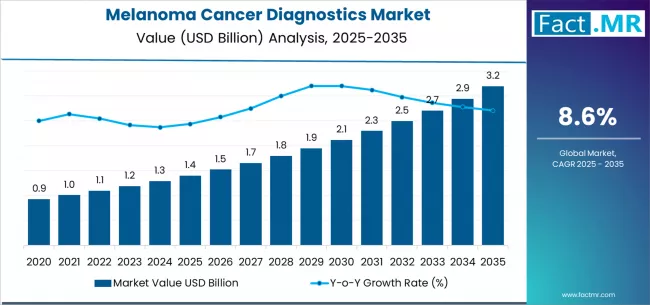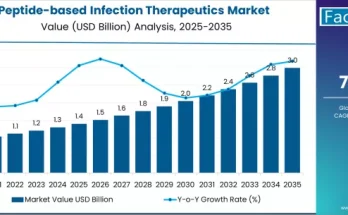The global melanoma cancer diagnostics market is poised for significant growth, driven by the rapid evolution of dermatological imaging, molecular diagnostics, and artificial intelligence–based screening tools. According to a recent report by Fact.MR, the market’s valuation is expected to increase from USD 1.4 billion in 2025 to USD 3.2 billion by 2035, expanding at a compound annual growth rate (CAGR) of 8.6%. This strong momentum reflects accelerating adoption of advanced diagnostic systems among healthcare providers, dermatology specialists, and oncology service networks worldwide.
Strategic Market Drivers
- Surge in Early Detection and Screening Programs
Global awareness campaigns and early detection initiatives are reshaping melanoma care pathways. Healthcare systems are prioritizing early diagnosis through skin cancer screening programs, supported by high-resolution dermatoscopes, teledermatology platforms, and AI-integrated image analytics. Early-stage detection not only reduces mortality rates but also lowers treatment costs, strengthening the demand for innovative diagnostic tools.
- Rise of Molecular and Genetic Testing
The integration of next-generation sequencing (NGS) and liquid biopsy technologies has revolutionized melanoma diagnostics. Molecular assays now enable oncologists to identify BRAF, NRAS, and c-KIT mutations, guiding personalized treatment plans and immunotherapy eligibility. As precision oncology expands, companion diagnostic collaborations between pharmaceutical and diagnostic firms are unlocking new revenue opportunities.
- Technological Innovation in Dermatological Imaging
AI-powered diagnostic systems, 3D total-body imaging, and smartphone-based lesion analysis are redefining dermatology practice. Companies are investing in machine-learning algorithms capable of distinguishing malignant from benign lesions with clinical-grade accuracy. These tools enhance diagnostic speed and enable remote patient assessment—particularly vital in telehealth-driven care models.
- Growing Demand from Oncology and Pathology Networks
The increasing prevalence of skin cancer—particularly in North America, Europe, and Australia—continues to stimulate demand for integrated diagnostic solutions that combine imaging, histopathology, and molecular analysis. Oncology centers are adopting end-to-end diagnostic workflows to improve case turnaround and accuracy, fostering partnerships between hospitals, pathology labs, and digital health startups.
Browse Full Report: https://www.factmr.com/report/57/melanoma-cancer-diagnostics-market
Regional Growth Highlights
North America: Innovation and Advanced Healthcare Integration
North America remains the largest regional market, with the U.S. leading in adoption of AI-driven imaging and molecular testing. Strong healthcare infrastructure, high awareness, and a rising patient pool with fair skin types drive market dominance. Collaborations between academic research centers and diagnostic innovators continue to accelerate clinical validation and adoption.
Europe: Regulation-Backed Technological Expansion
Europe’s melanoma diagnostics landscape is influenced by stringent clinical standards and government-supported cancer screening programs. Germany, the U.K., and France are major contributors, investing in digital pathology and teledermatology. EU-backed funding for cancer prevention and AI integration further supports diagnostic modernization.
Asia-Pacific: Fastest-Growing Regional Opportunity
Asia-Pacific is emerging as the fastest-growing region, driven by expanding healthcare access, rising disposable incomes, and increasing melanoma incidence due to changing lifestyle patterns. Countries such as Japan, South Korea, and Australia are rapidly adopting digital imaging and molecular diagnostic technologies in hospitals and private clinics.
Rest of the World: Building Diagnostic Infrastructure
Latin America and the Middle East are experiencing gradual uptake of melanoma diagnostics, supported by healthcare digitization, medical tourism, and government-led cancer control initiatives. Growing awareness among dermatologists and improved laboratory capabilities will further enhance diagnostic adoption over the next decade.
Market Segmentation Insights
By Diagnostic Type
- Imaging Devices – Dermatoscopes, confocal microscopes, and total-body imaging systems.
- Molecular Diagnostics – NGS, PCR-based assays, and companion diagnostics.
- Biopsy and Histopathology Tests – Conventional and automated pathology solutions.
- Immunohistochemistry (IHC) Assays – Widely used for confirming melanoma presence and subtypes.
- AI and Digital Diagnostic Tools – Algorithms for lesion recognition and predictive analytics.
By End User
- Hospitals & Oncology Centers – Dominant users of integrated diagnostic platforms.
- Diagnostic Laboratories – Expanding service offerings with molecular and imaging tools.
- Dermatology Clinics – Increasing adoption of handheld AI devices for real-time analysis.
- Research Institutes – Investing in genomic and biomarker studies for melanoma prognosis.
Key Market Challenges
- High Cost of Advanced Diagnostic Systems: Limits adoption in emerging markets.
- Data Privacy and Regulatory Hurdles: Integration of AI and digital imaging requires strict compliance.
- Limited Access in Rural Regions: Diagnostic inequality continues to affect early detection outcomes.
- Reimbursement Uncertainty: Lack of clear policies for AI and molecular tests in some regions hinders market expansion.
Competitive Landscape
The melanoma cancer diagnostics market is characterized by strong competition among global and regional players, focusing on precision diagnostics, data-driven imaging, and companion diagnostics development.
Key Players in the Melanoma Cancer Diagnostics Market:
- Roche
- Agilent/Dako
- BMS (Companion Dx Partners)
- Guardant Health
- Natera
- DermTech
- Castle Biosciences
- Philips
- Canon
- GE HealthCare
These companies are expanding their portfolios through strategic partnerships, R&D investment, and integration of AI analytics and genomic insights to deliver faster, more accurate diagnostic outcomes.
Future Outlook: Toward AI-Enabled and Personalized Cancer Diagnostics
The next decade will define a transformational phase for melanoma diagnostics, characterized by convergence of AI, genomics, and digital pathology. Increasing investments in biomarker discovery, remote diagnostics, and integrated care ecosystems will enable earlier, more accurate detection and personalized treatment planning.
As healthcare systems prioritize precision oncology, companies embracing innovation, affordability, and data transparency will lead the next wave of diagnostic excellence—bringing the goal of zero-delay melanoma detection closer to reality.



